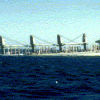Although the vessel was initially considered salvageable, further damage caused by the reef rendered the vessel beyond salvage. The ship broke up over the next two weeks and released its cargo of 30,000 tonnes of soluble fertiliser, and bunkers of some 700 tonnes (mainly heavy fuel oil). The majority of the fuel ended up on the beaches of Cape Le Grand National Park.
Open ocean conditions and inclement weather restricted the application of dispersants on the concentrated oil in the vicinity of the ship. Foreshore clean-up operations continued for more than nine weeks.
National Plan equipment used included:
- some 200 drums of dispersant
- considerable quantities of sorbents
- 600 metres of boom (which was damaged beyond repair during the response operation).
Clean-up operations were successful, with no long term impact from the oil.
Ship details
The Sanko Harvest was a 30,000 DWT bulk carrier owned by Sanko Shipping Line of Japan, operated by Eastern Shipping Company (a wholly owned subsidiary of Sanko), registered in Panama, with a Korean crew of 20, and carrying a cargo of 30,000 tonnes of highly soluble fertiliser and bunkers of 700 tonnes (mainly heavy fuel oil). The ship was on passage from Tampa in the USA to Esperance, Western Australia.
The ship was entered with the Gard Protection and Indemnity (P & I) Club of Norway which is represented in Fremantle by C & R Cox & Associates.
Details of the pollution incident
Although the vessel was initially considered salvageable, after 24 hours of further damage against the reef it was rendered beyond salvage. This markedly changed the entire operation from primarily salvage to one of pollution combat.
The ship broke up over the next two weeks and released its cargo and bunker fuel into the sea. The cargo dissolved and dispersed and there were no practical measures that could be taken to prevent or limit this occurring. The majority of the fuel ended up on the beaches of Cape Le Grand National Park.
The National Plan State Committee initiated salvage and pollution combat operations in conjunction with government agencies and the owners. Action to limit pollution was restricted by the open ocean and weather conditions. Dispersant was applied to concentrated oil in the vicinity of the ship, and foreshore clean-up operations were primarily limited to beach areas. The clean-up continued for nine and a half weeks.
Outcome
Two colonies of endangered New Zealand Fur seal pups were oiled and a rescue operation, initiated by CALM, was able to clean and save over 80 per cent of all oiled seal pups.
There were only 20 reported bird deaths and no reported fish deaths.
A monitoring program was commissioned by the Environment Protection Authority and no adverse effects from the fertiliser were detected.
The beaches were cleaned up and it is expected no long-term impact from the oil will result.
The oil pollution combat operations following the wreck of the Sanko Harvest were successful. This was due to the effort and cooperation of all the people and agencies involved, including the owners and their insurers.

Photo: Australian Maritime Incident Investigation Unit
Related information
Read about Australia's National Plan for Maritime Environmental Emergencies.